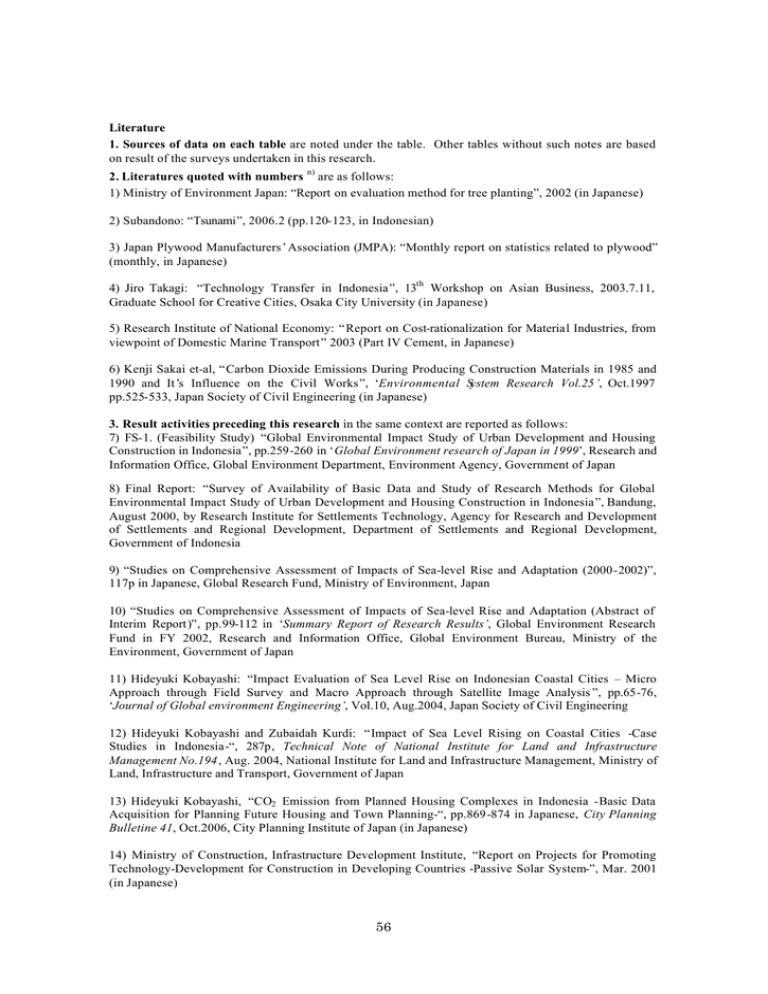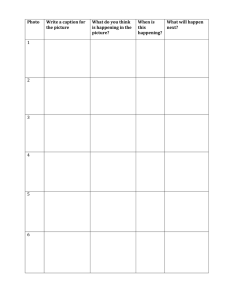Literature 1. Sources of data on each table are noted under the table
advertisement

Literature 1. Sources of data on each table are noted under the table. Other tables without such notes are based on result of the surveys undertaken in this research. 2. Literatures quoted with numbers n) are as follows: 1) Ministry of Environment Japan: “Report on evaluation method for tree planting”, 2002 (in Japanese) 2) Subandono: “Tsunami”, 2006.2 (pp.120-123, in Indonesian) 3) Japan Plywood Manufacturers’ Association (JMPA): “Monthly report on statistics related to plywood” (monthly, in Japanese) 4) Jiro Takagi: “Technology Transfer in Indonesia”, 13th Workshop on Asian Business, 2003.7.11, Graduate School for Creative Cities, Osaka City University (in Japanese) 5) Research Institute of National Economy: “Report on Cost-rationalization for Material Industries, from viewpoint of Domestic Marine Transport” 2003 (Part IV Cement, in Japanese) 6) Kenji Sakai et-al, “Carbon Dioxide Emissions During Producing Construction Materials in 1985 and 1990 and It’s Influence on the Civil Works”, ‘Environmental System Research Vol.25’, Oct.1997 pp.525-533, Japan Society of Civil Engineering (in Japanese) 3. Result activities preceding this research in the same context are reported as follows: 7) FS-1. (Feasibility Study) “Global Environmental Impact Study of Urban Development and Housing Construction in Indonesia”, pp.259-260 in ‘Global Environment research of Japan in 1999’, Research and Information Office, Global Environment Department, Environment Agency, Government of Japan 8) Final Report: “Survey of Availability of Basic Data and Study of Research Methods for Global Environmental Impact Study of Urban Development and Housing Construction in Indonesia”, Bandung, August 2000, by Research Institute for Settlements Technology, Agency for Research and Development of Settlements and Regional Development, Department of Settlements and Regional Development, Government of Indonesia 9) “Studies on Comprehensive Assessment of Impacts of Sea-level Rise and Adaptation (2000-2002)”, 117p in Japanese, Global Research Fund, Ministry of Environment, Japan 10) “Studies on Comprehensive Assessment of Impacts of Sea-level Rise and Adaptation (Abstract of Interim Report)”, pp.99-112 in ‘Summary Report of Research Results’, Global Environment Research Fund in FY 2002, Research and Information Office, Global Environment Bureau, Ministry of the Environment, Government of Japan 11) Hideyuki Kobayashi: “Impact Evaluation of Sea Level Rise on Indonesian Coastal Cities – Micro Approach through Field Survey and Macro Approach through Satellite Image Analysis ”, pp.65-76, ‘Journal of Global environment Engineering’, Vol.10, Aug.2004, Japan Society of Civil Engineering 12) Hideyuki Kobayashi and Zubaidah Kurdi: “Impact of Sea Level Rising on Coastal Cities -Case Studies in Indonesia-“, 287p, Technical Note of National Institute for Land and Infrastructure Management No.194, Aug. 2004, National Institute for Land and Infrastructure Management, Ministry of Land, Infrastructure and Transport, Government of Japan 13) Hideyuki Kobayashi, “CO2 Emission from Planned Housing Complexes in Indonesia -Basic Data Acquisition for Planning Future Housing and Town Planning-“, pp.869-874 in Japanese, City Planning Bulletine 41, Oct.2006, City Planning Institute of Japan (in Japanese) 14) Ministry of Construction, Infrastructure Development Institute, “Report on Projects for Promoting Technology-Development for Construction in Developing Countries -Passive Solar System-”, Mar. 2001 (in Japanese) 56



